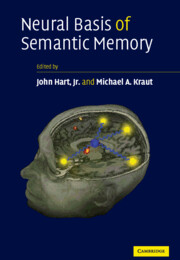Book contents
- Frontmatter
- Contents
- List of contributors
- Preface
- Part I Semantic Memory: Building Models from Lesions
- Part II Insights from Electrophysiology
- Part III Applications of Models to Understanding Cognitive Dysfunction
- Part IV Representations of Nouns and Verbs vs. Objects and Actions
- 6 Effects of word imageability on semantic access: neuroimaging studies
- 7 The neural systems processing tool and action semantics
- 8 The semantic representation of nouns and verbs
- Part V Critical Role of Subcortical Nuclei in Semantic Functions
- Part VI Conceptual Models of Semantics
- Index
- References
7 - The neural systems processing tool and action semantics
from Part IV - Representations of Nouns and Verbs vs. Objects and Actions
Published online by Cambridge University Press: 14 September 2009
- Frontmatter
- Contents
- List of contributors
- Preface
- Part I Semantic Memory: Building Models from Lesions
- Part II Insights from Electrophysiology
- Part III Applications of Models to Understanding Cognitive Dysfunction
- Part IV Representations of Nouns and Verbs vs. Objects and Actions
- 6 Effects of word imageability on semantic access: neuroimaging studies
- 7 The neural systems processing tool and action semantics
- 8 The semantic representation of nouns and verbs
- Part V Critical Role of Subcortical Nuclei in Semantic Functions
- Part VI Conceptual Models of Semantics
- Index
- References
Summary
This chapter discusses the contributions of functional imaging to our understanding of how action and tool concepts are represented and processed in the human brain. Section 7.1 introduces cognitive models of semantic organization. Section 7.2 provides a brief overview of functional imaging approaches to identify brain regions that have specialized for processing action and tool representations. Section 7.3 discusses the relationship between the visuomotor system and semantic processing of actions. Section 7.4 investigates the effects of action type and visual experience on action-selective responses. Section 7.5 characterizes the neural systems engaged in tool processing and how they are modulated by task and stimulus modality. Section 7.6 delineates future directions that may enable us to characterize the neural mechanisms that mediate tool and action-selective brain responses.
Cognitive models of semantic organization
Since the seminal work of Warrington and Shallice (1984), double dissociations of semantic deficits have been established between tools and animals (for review, see Gainotti et al., 1995; Warrington & Shallice, 1984; Capitani et al., 2003; Gainotti & Silveri, 1996; Farah et al., 1996; Hillis & Caramazza, 1991; Sacchett & Humphreys, 1992; Warrington & McCarthy, 1987). These double dissociations persist even when attempts are made to control general processing differences due to confounding variables such as familiarity, visual complexity, or word frequency (Farah et al., 1996; Sartori et al., 1993). They appear, therefore, to reflect some sort of semantic organization at the neuronal level.
Many cognitive models have been offered to explain these category-specific deficits.
Keywords
Information
- Type
- Chapter
- Information
- Neural Basis of Semantic Memory , pp. 182 - 204Publisher: Cambridge University PressPrint publication year: 2007
